|
|
|
Sort Order |
|
|
|
Items / Page
|
|
|
|
|
|
|
| Srl | Item |
| 1 |
ID:
143302
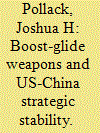

|
|
|
|
|
| Summary/Abstract |
The United States and China are testing boost-glide weapons, long-range strike systems capable of flying at Mach 5 or faster through the upper atmosphere. For the United States, these systems would provide a conventional prompt global strike capability, which, together with US ballistic missile defense programs, Chinese experts regard as a threat to China's ability to conduct nuclear retaliation. This perception is encouraging the Chinese military to modify its nuclear posture in ways that tend to create greater risks for both sides. If China's own boost-glide systems are meant to carry nuclear payloads only, their deployment would not fundamentally alter the current situation between the two states. However, if they were conventionally armed or dual-purpose, or if the United States could not determine the payloads they carried, the deployment of Chinese boost-glide systems could compound problems of strategic stability created by the introduction of ballistic missile defense, antisatellite, and antiship ballistic missile capabilities. If the technical hurdles can be overcome, it may be difficult for the two sides to refrain from these deployments in the absence of strong mutual trust or an established arms-control relationship. New confidence-building measures and expanded mutual transparency are warranted to avoid creating new dangers.
|
|
|
|
|
|
|
|
|
|
|
|
|
|
|
|
| 2 |
ID:
143304
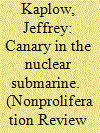

|
|
|
|
|
| Summary/Abstract |
The Treaty on the Non-Proliferation of Nuclear Weapons (NPT) allows states to exempt nuclear material from international safeguards for use in nuclear submarine programs. This material, however, could be diverted for nuclear weapons purposes without the knowledge of inspectors, creating a potentially dangerous loophole in the treaty. This article argues that exercising that loophole today would amount to admitting a nuclear weapon program, making it a particularly poor pathway to a weapon for a potential proliferant. Still, if states like Brazil ultimately exempt nuclear material from safeguards for a nuclear submarine effort, they could set a dangerous precedent that makes it easier for others to use the loophole as a route to a nuclear weapon capability. There are several policy options available to mitigate the damage of such a precedent; most promising is the prospect of a voluntary safeguards arrangement that would allow international inspectors to keep an eye on nuclear material even after it has been dedicated to a naval nuclear propulsion program.
|
|
|
|
|
|
|
|
|
|
|
|
|
|
|
|
| 3 |
ID:
143307


|
|
|
|
|
| Summary/Abstract |
Since 2002, NATO's territorial missile defense has evoked continuous debates between NATO states and the Russian Federation. Thirteen years have passed without reaching a common denominator. This article provides a comprehensive overview of the historical background of the debate and the technical details of the missile defense system, highlighting its shortcomings and the state of its deployment process. It also contrasts the military-technical and political arguments of both sides, before addressing the applicable norms of international law to highlight violations and the effect of this noncompliance on existing arms control measures.
|
|
|
|
|
|
|
|
|
|
|
|
|
|
|
|
| 4 |
ID:
143306


|
|
|
|
|
| Summary/Abstract |
The present international standard allows non-nuclear weapon states (NNWS) to forego safeguards when nuclear material is used in a “non-proscribed military activity,” though no criteria have been established to determine when NNWS can remove naval nuclear material from safeguards. Though at present, only nuclear-armed states possess nuclear submarines, the global nuclear naval landscape may soon change with the advancement of Brazil's fledgling program and the possible precedent it would set for other NNWS. A framework is needed to shore up nuclear security and prevent nuclear material diversion from the nuclear naval sector. Proposed and existing nonproliferation frameworks, including a Fissile Material Cut-off Treaty and commitments through the nuclear security summits, are insufficient to close this loophole. A Naval Use Safeguards Agreement (NUSA), modeled after the Additional Protocol of the International Atomic Energy Agency, would provide a framework to remove the opacity surrounding nuclear material in the naval sector. Designed for NNWS and encouraged as confidence-building measures for nuclear weapon states, NUSA would explicitly outline those stages in the naval nuclear fuel cycle where safeguards are to be applied and in what context. This viewpoint also further provides direction for targeted research and development in technical naval nuclear safeguards solutions.
|
|
|
|
|
|
|
|
|
|
|
|
|
|
|
|
| 5 |
ID:
143305


|
|
|
|
|
| Summary/Abstract |
There is a lingering disagreement among scholars on how the Treaty on the Non-Proliferation of Nuclear Weapons (NPT) affects nonproliferation and disarmament outcomes. Drawing on constructivist scholarship on international norms, this article examines the extent of the NPT's effect in the case of Ukraine's nuclear disarmament. In the wake of the Soviet Union's collapse, Ukraine found itself host to the world's third largest nuclear arsenal. Despite Ukraine's initial commitment to become a non-nuclear state, it proceeded along a difficult path toward NPT accession. Most controversial and directly at odds with the NPT was Ukraine's claim to ownership of its nuclear inheritance as a successor state of the Soviet Union. This article argues that, while much domestic discourse about the fate of these nuclear weapons was embedded in the negotiation of Ukraine's new identity as a sovereign state vis-à-vis Russia and the West, the NPT played an important, structural role by outlining a separate normative space for nuclear weapons and providing the grammar of denuclearization with which Ukraine's decision makers had to grapple.
|
|
|
|
|
|
|
|
|
|
|
|
|
|
|
|
| 6 |
ID:
143303
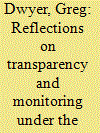

|
|
|
|
|
| Summary/Abstract |
The 1993 Highly Enriched Uranium (HEU) Purchase Agreement between the United States and Russian Federation is often described as one of the world's most successful nuclear nonproliferation programs. In 2013, the two states achieved the agreement's major goals of downblending 500 metric tons of Russian weapon-origin HEU to low enriched uranium (LEU) and delivering all resultant LEU to the United States. At one time, the LEU delivered under the agreement generated nearly 10 percent of all electricity in the United States. The agreement achieved its nonproliferation goals through a unique government/industry partnership. Commercial executive agents contracted for the annual sale and delivery of downblended LEU, while the US and Russian governments exercised reciprocal transparency monitoring measures to demonstrate that all LEU delivered under the agreement was derived from Russian weapons-origin HEU, and that the same LEU was used for exclusively peaceful purposes in the United States. The commercial development, negotiations, and implementation of the agreement have been well documented. This article describes the scope of US transparency monitoring activities in Russian HEU processing facilities, as well as Russian monitoring in the United States. In addition, it discusses the results of twenty years of reciprocal transparency monitoring and data analysis, and outlines lessons learned that are potentially applicable to future transparency monitoring and verification regimes and similar cooperative efforts.
|
|
|
|
|
|
|
|
|
|
|
|
|
|
|
|
| 7 |
ID:
143301
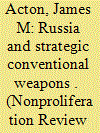

|
|
|
|
|
| Summary/Abstract |
Russian political leaders and military strategists are growing increasingly concerned about “strategic conventional weapons”—a broad category that appears to include all non-nuclear, high-precision, standoff weapons—and about long-range, hypersonic weapons, in particular. These concerns are complex and multifaceted (and, in some cases, contradictory), but chief among them are the beliefs that strategic conventional weapons could prove decisive in a major conflict and that Russia is lagging behind in their development. US programs to develop and acquire such weapons—namely, the Conventional Prompt Global Strike program—are of great concern to Russian strategists, who argue both that the United States seeks such weapons for potential use against Russia—its nuclear forces, in particular—and because strategic conventional weapons are more “usable” than nuclear weapons. Asymmetric responses by Russia include increased reliance on tactical nuclear weapons, efforts to enhance the survivability of its nuclear forces, and investments in air and missile defenses. There is also strong—but not completely conclusive evidence—that Russia is responding symmetrically by attempting to develop a long-range, conventionally armed boost-glide weapon.
|
|
|
|
|
|
|
|
|
|
|
|
|
|
|
|
| 8 |
ID:
143300
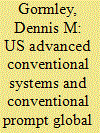

|
|
|
|
|
| Summary/Abstract |
The dangers and risks of employing a Conventional Prompt Global Strike (CPGS) capability greatly exceed the benefits. More suitable, if less prompt, alternatives exist to deal with fleeting targets. Even a niche CPGS capability—consisting of approximately twenty systems—carries risks, to say nothing of proposals to develop hundreds or more. Most dangerously, CPGS could stir the pre-emption pot, particularly vis-à-vis states that correctly perceive to be within the gunsights of US CPGS weapons; other states, too, may feel emboldened to emulate this US precedent and undertake their own form of prompt, long-range strike capability. Compressed circumstances surrounding such a scenario could foster unwanted erratic behavior, including the misperception that the threatening missile carries a nuclear weapon. But the true Achilles's heel of the CPGS concept is the unprecedented demands it places on the intelligence community to provide decision makers with “exquisite” intelligence within an hour timeframe. Such compressed conditions leave decision makers with virtually no time to appraise the direct—and potentially unintended—consequences of their actions.
|
|
|
|
|
|
|
|
|
|
|
|
|
|
|
|
|
|
|
|
|